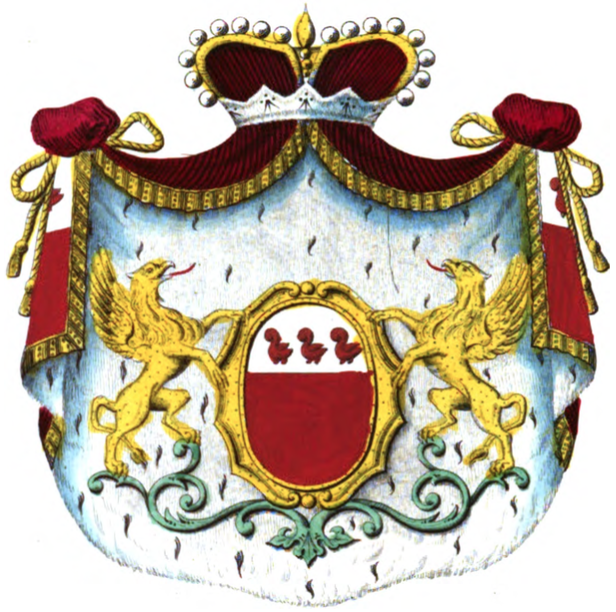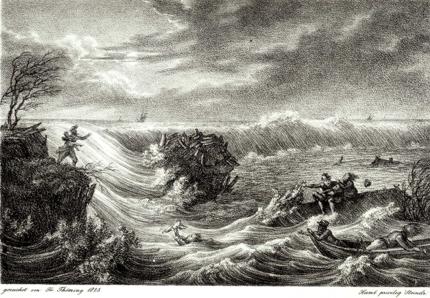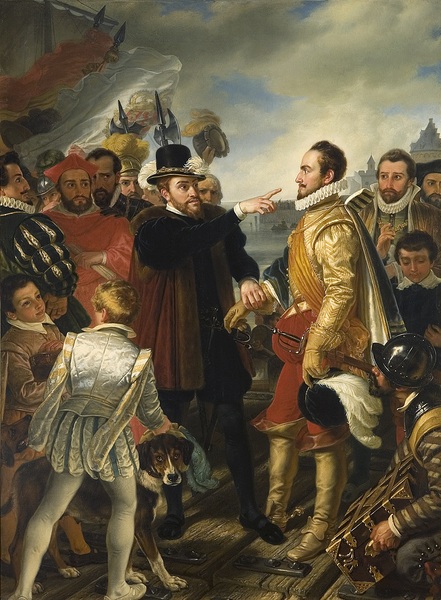|
Hingene
Hingene is a village and ''deelgemeente'' (sub-municipality) of the municipality of Bornem in the province of Antwerp, Belgium. The village is bordered to the north by the Scheldt and to the east by the Rupel. It is located about south-west of the city of Antwerp. History In 1846, a hoard of coins was discovered in Hingene from the Roman era. Due to its proximity to the Scheldt and Rupel, the area mainly consists of ''polder'' land. Early dike building started in the 11th century, and during the 15th century the rivers were constrained by dikes. The early history of the area is characterised by rivalry with Bornem. In 1535, Hingene became property of Henry III of Nassau-Breda. His nephew William the Silent became Stadtholder of Holland, Zeeland and Utrecht, and was forced to sell Hingene in 1560 as an independent ''heerlijkheid'' to the Lord of Grobbendonk whose family later became known as the Dukes of Ursel. The Ursel family lived in the D'Ursel Castle whose domain dominat ... [...More Info...] [...Related Items...] OR: [Wikipedia] [Google] [Baidu] |
Ursel Family
The House of Ursel is the name of an important old Belgian noble family of German origin. The Head of the House is styled the Duke of Ursel, while other members are styled as Count/Countess d'Ursel. History The Ursel family roots are in Schmalkalden, Germany, and were collateral branch of the House of Schetzenberg. In the late 15th century, some members moved to Hasselt and Antwerp. Amongst the family members we find Gaspard II Schetz, the Lord of Grobbendonck, who married Catherine van Ursel, daughter of Lancelot II of Ursel. The three daughters of Lancelot II died without heirs, and by request of Barbe of Ursel, Conrad III Schetz was adopted by her. His descendants carrying the name 'van Ursel'. The ancestors of Lancelot II came from Antwerp, and held important offices. Conrad Albert, Baron of Wesemael and Lord of Highene was created First Duke of Ursel by imperial decree of Charles VI on 19 August 1716 and later he was created First Duke of Hoboken on 24 April 1 ... [...More Info...] [...Related Items...] OR: [Wikipedia] [Google] [Baidu] |
D'Ursel Castle
D'Ursel Castle ( nl, Kasteel van Hingene, also known as the ''Kasteel d'Ursel'') used to be the private summer residence of the Duke of Ursel in Hingene in the municipality of Bornem, province of Antwerp, Belgium. Today it is property of the State, and opened to the public. History The first resident was Diederik van de Werve (1519-1598), his descendants sold it to Conrad III Schetz in 1608. The estate became the summer residence of the House of Ursel. The Dukes of Ursel and their family resided for 350 years on the estate. Its original view can be seen in the ''Flandria Illustrata''. A famous resident was Conrard-Albert, first Duke of Ursel (1665-1738). His son, Charles, 2nd Duke d'Ursel asked Giovanni Niccolò Servandoni (1695-1766) to redesign the family estate. The front was made symmetric like a palace. The duke received important noblemen here, such as Johan von Sinzendorf und Pottendorf (1739-1813) and Joseph de Ferraris. During the 18th century the castle was known fo ... [...More Info...] [...Related Items...] OR: [Wikipedia] [Google] [Baidu] |
Martin Van Den Bossche
Martin Van Den Bossche (born 10 March 1941) is a retired Belgian professional road bicycle racer. Van Den Bossche finished in the top 10 of the Tour de France twice, and won the Mountains classification of the 1970 Giro d'Italia. Major results ;1963 : 4th Druivenkoers Overijse ;1964 : 1st Schaal Sels-Merksem : 4th Grand Prix des Nations : 5th Road race, National Road Championships : 5th Liège–Bastogne–Liège : 5th GP Stad Zottegem : 7th Grand Prix de Denain ;1965 : 3rd Liège–Bastogne–Liège : 4th Scheldeprijs : 5th Grand Prix Pino Cerami : 7th Grand Prix de Denain : 9th GP Stad Zottegem ;1966 : 2nd Grand Prix de Denain : 9th Road race, National Road Championships : 10th Road race, UCI Road World Championships : 10th Overall Tour de France ;1967 : 3rd Circuit des Frontières : 3rd GP Stad Vilvoorde : 8th Overall Tour of Belgium : 8th Grand Prix Pino Cerami ;1968 : 1st Stage 3a ( TTT) Paris–Luxembourg : 2nd Coppa Ugo Agostoni : 4th Overall Setmana Catalana de Ciclisme : ... [...More Info...] [...Related Items...] OR: [Wikipedia] [Google] [Baidu] |
Jules Mees
Juliaan or Jules Mees (1876–1937) was a Belgian professor of historical geography, a specialist on the Portuguese discoveries, who in 1920 was condemned to two years in prison for collaboration during the German occupation of Belgium in World War I. Life Mees was born in Hingene, Province of Antwerp (Belgium) on 26 September 1876. After secondary education at the Onze-Lieve-Vrouwcollege in Boom, Belgium he studied history at Ghent University, graduating Ph.D. in 1899 with a thesis on the discovery of the Azores Islands. In 1900-1902 he pursued further studies in economic history and historical geography at the universities of Munich and Vienna, and in 1902-1903 taught at a state secondary school in Ghent. In 1903 he obtained a position in the State Archives. He also taught at the École Supérieure Commerciale et Consulaire in Mons. In 1917 he accepted a position at the German-sponsored Vlaamsche Hogeschool (Von Bissing university). In 1920 he stood trial as a collaborator and w ... [...More Info...] [...Related Items...] OR: [Wikipedia] [Google] [Baidu] |
Bornem
Bornem (, old spelling: ''Bornhem'') is a municipality located in the Belgian province of Antwerp. The municipality comprises the village of Bornem proper, Hingene, and Weert, and . There are also the hamlets of Branst, Buitenland, Eikevliet and Wintam. In 2021, Bornem had a total population of 21,428. The total area is 45.76 km². Geography Heritage * Bornem Castle, Residence of the House Marnix de Sainte-Aldegonde. * Bornem Abbey, only Cistercian Abbey in Flanders: residence of former general Amadeus de Bie and Henricus Smeulders. Climate Bornem has a oceanic climate ( Köppen: ''Cfb''). Notable people * Walter Boeykens Walter, Knight Boeykens (January 6, 1938 – April 23, 2013) was a Belgian conductor and a world-renowned clarinetist. Boeykens' impressive discography, including several critically acclaimed performances, are testimony to his status as one of t ... (b. Bornem, 6 January 1938), clarinetist * Pedro Coloma, Baron of Bornhem, who purchas ... [...More Info...] [...Related Items...] OR: [Wikipedia] [Google] [Baidu] |
Polder
A polder () is a low-lying tract of land that forms an artificial hydrological entity, enclosed by embankments known as dikes. The three types of polder are: # Land reclaimed from a body of water, such as a lake or the seabed # Flood plains separated from the sea or river by a dike # Marshes separated from the surrounding water by a dike and subsequently drained; these are also known as '' koogs'', especially in Germany The ground level in drained marshes subsides over time. All polders will eventually be below the surrounding water level some or all of the time. Water enters the low-lying polder through infiltration and water pressure of groundwater, or rainfall, or transport of water by rivers and canals. This usually means that the polder has an excess of water, which is pumped out or drained by opening sluices at low tide. Care must be taken not to set the internal water level too low. Polder land made up of peat (former marshland) will sink in relation to its previo ... [...More Info...] [...Related Items...] OR: [Wikipedia] [Google] [Baidu] |
Ruisbroek, Antwerp
Ruisbroek is a village in the municipality of Puurs-Sint-Amands located in the Antwerp Province of Belgium. Ruisbroek was an independent municipality until 1977 was merged into Puurs. In 2019, Puurs itself was merged into Puurs-Sint-Amands. Floods Ruisbroek is a polder village protected by dikes which has often seen severe flooding. In 1820, a whole neighbourhood was flooded, and was rebuilt north of the Rupel River. The last flood which occurred was a result of the gale of January 1976. The dike broke over a distance of 100 metres, and flooded part of the village. King Baudouin of Belgium Baudouin (;, ; nl, Boudewijn Albert Karel Leopold Axel Maria Gustaaf, ; german: Balduin Albrecht Karl Leopold Axel Maria Gustav. 7 September 1930 – 31 July 1993), Dutch name Boudewijn, was King of the Belgians from 17 July 1951 until his de ... visited the town on 6 January 1976. During his visit he was confronted with an angry crowd and accusations. De Waterhoek monument indicates the ... [...More Info...] [...Related Items...] OR: [Wikipedia] [Google] [Baidu] |
February Flood Of 1825
{{short description, Storm surge flood on the North Sea coast of Germany and the Netherlands The February flood of 1825, also known in Germany as the Great Hallig Flood (''Große Halligflut''), was a devastating flood that occurred from 3 to 5 February 1825 on the North Sea coast in which about 800 people were drowned. Particularly affected was the North Sea coast of Jutland, Slesvig and Germany. The sand spit Agger Tange was broken through, and the Limfjord got its western opening to the sea. Henceforth, North Jutland has been an island. In North Frisia, the unprotected islets, known as Halligen, were hit. Many dykes had already been damaged in November the year before by a severe storm surge. The island of Pellworm was completely flooded. In East Frisia, the town of Emden was particularly hard hit. However, because the levees in the East Frisian area had been raised significantly in many places in the preceding years, the number of casualties, about 200, was smaller than i ... [...More Info...] [...Related Items...] OR: [Wikipedia] [Google] [Baidu] |
Lord Of Grobbendonk
Lord of Grobbendonk is a feudal Flemish title originating from Grobbendonk. This title belongs today to the Belgian nobility. History The origin of this important hereditary title goes back to the 13th century. The lordship was in possession of different Flemish noble houses at different times: van Wilre, van Crayenhem, Brant, van Jauche, van Mastaing, and finally Schetz. The lordship was created a county in 1637 by royal decree of King Philip IV of Spain. Currently it is held by the descendants of the house of Schetz: the current duke of Ursel is still Count of Grobbendonk. Lords of Grobbendonk * Hendrik van Wilre, Lord of Grobbendonk and Lord Mayor of Leuven. * Arnold, Lord of Crayenhem and Grobbendonq, died 1302. x Marie of Wesemaele. *Arnold II of Crayenhem 1360-, Lord of Grobbendonk. ** Isabeau of Craienhem, Lady of Grobbendoncq, married to Jean III Brant, 3rd lord of Ayseau. ***Arnoult Brant, Lord of Grobbendoncq; married to Catherine of Heinsberge. ****Marghareta Bran ... [...More Info...] [...Related Items...] OR: [Wikipedia] [Google] [Baidu] |
Heerlijkheid
A ''heerlijkheid'' (a Dutch word; pl. ''heerlijkheden''; also called ''heerschap''; Latin: ''Dominium'') was a landed estate that served as the lowest administrative and judicial unit in rural areas in the Dutch-speaking Low Countries before 1800. It originated as a unit of lordship under the feudal system during the Middle Ages. The English equivalents are ''manor'', '' seigniory'' and '' lordship''.. The translation used by J.L. Price in ''Dutch Society 1588-1713'' is "manor"; by David Nicholas in ''Medieval Flanders'' is "seigneury". The German equivalent is '' Herrschaft''. The ''heerlijkheid'' system was the Dutch version of manorialism that prevailed in the Low Countries and was the precursor to the modern municipality system in the Netherlands and Flemish Belgium. Characteristics and types A typical ''heerlijkheid'' manor consisted of a village and the surrounding lands extending out for a kilometre or so. Taking 18th-century Wassenaar as an example of a large ''hoge he ... [...More Info...] [...Related Items...] OR: [Wikipedia] [Google] [Baidu] |
Stadtholder
In the Low Countries, ''stadtholder'' ( nl, stadhouder ) was an office of steward, designated a medieval official and then a national leader. The ''stadtholder'' was the replacement of the duke or count of a province during the Burgundian and Habsburg period (1384 – 1581/1795). The title was used for the official tasked with maintaining peace and provincial order in the early Dutch Republic and, at times, became ''de facto'' head of state of the Dutch Republic during the 16th to 18th centuries, which was an effectively hereditary role. For the last half century of its existence, it became an officially hereditary role under Prince William IV of Orange. His son, Prince William V, was the last ''stadtholder'' of the republic, whose own son, William I of the Netherlands, became the first sovereign king of the United Kingdom of the Netherlands. The title ''stadtholder'' is roughly comparable to the historical titles of Lord Protector in England, Statthalter in the Holy Roma ... [...More Info...] [...Related Items...] OR: [Wikipedia] [Google] [Baidu] |
William The Silent
William the Silent (24 April 153310 July 1584), also known as William the Taciturn (translated from nl, Willem de Zwijger), or, more commonly in the Netherlands, William of Orange ( nl, Willem van Oranje), was the main leader of the Dutch Revolt against the Spanish Habsburgs that set off the Eighty Years' War (1568–1648) and resulted in the formal independence of the United Provinces in 1648. Born into the House of Nassau, he became Prince of Orange in 1544 and is thereby the founder of the Orange-Nassau branch and the ancestor of the monarchy of the Netherlands. In the Netherlands, he is also known as Father of the Fatherland ('' Pater Patriae'') ( nl, Vader des Vaderlands). A wealthy nobleman, William originally served the Habsburgs as a member of the court of Margaret of Parma, governor of the Spanish Netherlands. Unhappy with the centralisation of political power away from the local estates and with the Spanish persecution of Dutch Protestants, William joined the ... [...More Info...] [...Related Items...] OR: [Wikipedia] [Google] [Baidu] |

.jpg)



